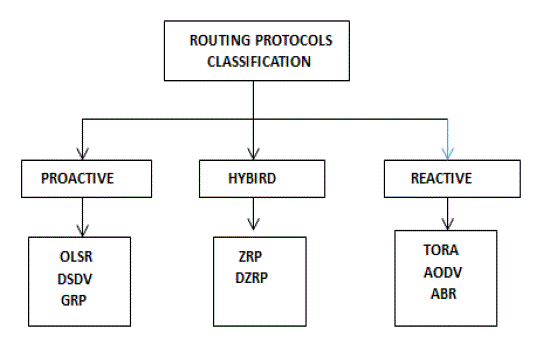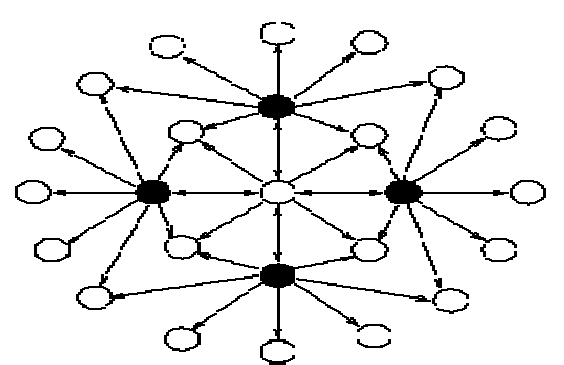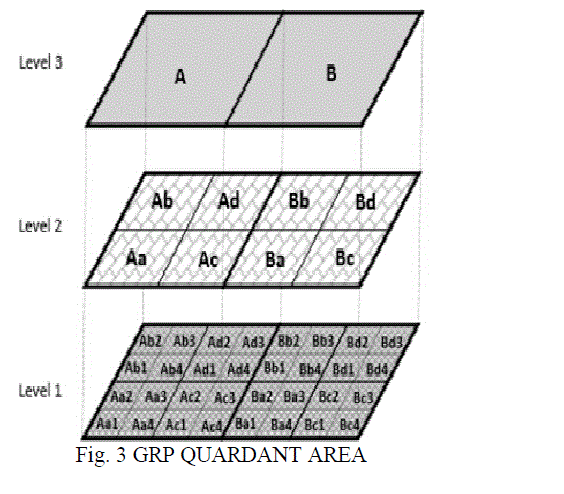Keywords
|
| GRP; MANET; OLSR; TORA; ZRP; ABR |
INTRODUCTION
|
| A mobile ad hoc network (MANET) is a self-configuring infrastructure less network of mobile devices connected by wirelessMANETs are vigorous in nature, they are used in many situations. MANETS are used in disaster situations, where we cannot afford to develop a wired network. Presently vast work has been done in the routing protocols used in MANETs. In this paper we aim to assess the performance of OLSR, GRP, ZRP, ABR and TORA routing protocols [1]. The routing protocols in MANETS are classified into three categories: proactive (table driven), reactive (demand driven), hybrid routing protocols. In this paper we have chosen each category routing protocols. Our aim is to compare all the Routing protocols based upon parameters. |
PROACTIVE ROUTING PROTOCOLS
|
| The Proactive Routing protocol is also called table driven protocol. In Proactive Routing each node updates and maintains its routing protocol every time the topology changes in the network. Therefore it is obscure task to store and maintain entries of each node. So this routing is not appropriate for large networks. Most proactive routing protocols proposed for mobile ad hoc networks have inherited properties from algorithms used in wired networks. The OLSR and GRP are examples of proactive routing explained below |
| a) Optimized link state routing- OLSR is a table driven protocol. It usually stores and updates its routes so when a route is needed, it present the route immediately without any initial delay. In OLSR, some candidate nodes called multipoint relays (MPRs) are selected and responsible to forward broadcast packets during the flooding process. This technique reduces the overhead of packet transmission compared to flooding mechanism. OLSR performs hop-by-hop routing, where each node uses its most recent routing information to route packets. MPR’s is made in a way that it covers all nodes that are two hops away (i.e. neighbours of the neighbours). A node senses and selects its MPR's with control messages called HELLO messages. Hello messages are used to ensure a bidirectional link with the neighbour. HELLO messages are sent at a certain interval. Nodes broadcast “TC” or Topology control messages to determine its MPR. |
| b) Geographic routing- Geographic routing has become one of the most suitable routing strategy in wireless mobile ad hoc network mainly due to its scalability. That is because there is no need to maintain explicit routes. The principle approach in geographic routing is greedy forwarding, which fails if the packet encounters a void node (i.e., a node with no neighbour closer to the destination than itself). Geographic routing protocols scale better for ad hoc networks mainly for two reasons one is that there is no necessity to keep routing tables up-to-date and second is that there is no need to have a global view of the network topology and its change. Therefore, geographic routing protocols have attracted a lot of attention in the field of routing protocols for MANETs. These geographic approaches allow routers to be nearly stateless because forwarding decisions are based on location information of the destination and the location information of all one-hop neighbours. |
REACTIVE ROUTING PROTOCOL
|
| Reactive routing protocols are acquiring routing information only when it is needed they are on-demand protocol. In reactive routing, a route determination process is invoked on demand when a source node request for a route to destination node. |
| a) Temporally Ordered Routing Algorithm- The TORA use a "flat", non-hierarchical routing algorithm which enable it to achieve a high degree of scalability. TORA builds and maintains a Directed Acyclic Graph (DAG).It is a source-initiated on-demand routing protocol. It finds multiple routes from a source node to a destination node. The main feature of TORA is that the control messages are localized to a very small set of nodes near the occurrence of a topological change. To achieve this, the nodes maintain routing information about adjacent nodes. The protocol has three basic functions: Route creation, Route maintenance and Route erasure. |
| b) Associativity Based Routing- The Associativity Based Routing (ABR) protocol is a new approach for routing .ABR defines a new metric for routing known as the degree of association stability. It is free from loops, deadlock, and packet duplicates. In ABR, a route is selected based on associativity states of nodes. The routes thus selected are liked to be long-lived. All node generate periodic beacons to signify its existence. When a neighbor node receives a beacon, it updates its associativity tables. For every beacon received, node increments its associativity tick with respect to the node from which it received the beacon. Association stability means connection stability of one node with respect to another node over time and space. A high value of associativity tick with respect to a node indicates a low state of node mobility, while a low value of associativity tick may indicate a high state of node mobility. Associativity ticks are reset when the neighbors of a node or the node itself move out of proximity. The fundamental objective of ABR is to find longer-lived routes for ad hoc mobile networks. The three phases of ABR are Route discovery, Route reconstruction (RRC) and Route deletion. |
HYBRID ROUTING PROTOCOL
|
| Hybrid protocol is association of the advantage of the both proactive and reactive routing protocol. |
| a) Zone Routing Protocol- The Zone Routing Protocol (ZRP) combines the qualities of the proactive and reactive approaches by maintaining an up- to-date topological map of a zone centred on each node . ZRP uses proactive approach for routing inside the zone i.e. intra-zone routingprotocol (IARP) and reactive approachfor routing outside the zone i.e. inter-zone routing protocol (IERP). |
LITERATURE SURVEY
|
| The performance comparison of various routing protocols over MANET namely-AODV, DSR, TORA, OLSR and GRP by varying the number of nodes with FTP and HTTP applications is done by Gagangeetsinghaujla and Sandeepsinghkang [4] .On the basis of throughput, delay, load and data dropped performance metrics. They concluded that results for ftp give the clear picture about the OLSR protocol’s best performance in all scenarios whereas the results for http application give the mixed picture. OLSR has highest throughput, least data dropped. TORA has high delay, load, data drop in all scenarios for ftp. DSR shows least throughput. GRP shows least delay. AODV gives highest throughput for http. |
| The performance comparison of MANET routing protocols, namely AODV, DSR, TORA and OLSR [5] is done by AshishShrestha and FiratTekiner which shows the overall performance of AODV and OLSR. However, AODV showed better efficiency to deal with high congestion and it proves better by successfully delivering packets over heavily trafficked network compared to OLSR and TORA. |
| Performance comparison of three routing protocol -AODV, DSDV and TORA under different network size is done by N Vetrivelan [6], A V Reddy shows that AODV performs well in terms of Average Delay, Packet Delivery Fraction and for Routing Load TORA performs well. In less stressful situation, the Packet Delivery Fraction, the TORA outperforms DSDV and AODV. |
| Comparison of OLSR and TORA is done by PankajPalta and Sonia Goyal [2] in which shows that OLSR is better in those scenario where bandwidth is large as OLSR always updated their nodes so large bandwidth is used than TORA on same conditions. |
| Performance comparison of OLSR, GRP and TORA using OPNET are compared on the basis of packets delay, load, media access and throughput by HarmanpreetKaur and Jaswinder Singh [7]. Comparison of AODV, TORA and DSR is also done by N.Adam, M.Y Ismail and J. Abdullah in terms of PDR, delay, throughput, dropped and routing load. AODV is best with minimum delay, packet delivery ratio and maximum throughput whereas TORA is worst. The simulation study for MANET network under five routing protocols AODV, DSR, OLSR, TORA and GRP were deployed using FTP traffic in .These protocols were tested with three QOS parameters. From their analysis, the OLSR outperforms others in both delay and throughput. Mr. L Raja, Capt. Dr. S SanthoshBaboo [9] has done the comparative study of reactive routing protocol AODV, DSR, ABR and TORA. |
COMPARISON OF ROUTING STRATEGIES AND PROTOCOLS
|
CHARACTERISTIC SUMMERY OF OLSR GRP TORA ABR ZRP
|
CONCLUSION
|
| Routing plays an important role in MANETs. These are dynamic networks where topology is changing very rapidly. Every time the topology changes the source to destination path also change, so implemented routing protocol must able to handle the all challenges of routing. We have discussed the three type of routing protocols. The proactive, reactive and hybrid routing protocol, with the help of taking example of each protocol. |
| The OLSR is most widely accepted routing protocol, it shows best throughput and delay. The performance of TORA shows worst results in compare to GRP and OLSR. The ABR is new scheme free from deadlock, with an good performance. The ZRP protocol is suitable for large networks. ZRP is not an independent protocol but rather a routing framework. Further, any evaluation of the ZRP version with support for unidirectional links could not be found. The overall conclusion of is that, the performance demand and the network size plays a key role in selecting the protocol to be implemented. It is quite natural that one particular solution cannot be applied for all sorts of situations and, even if applied, might not be optimal in all cases. Often it is more appropriate to apply a hybrid protocol rather than a strictly proactive or reactive protocol as hybrid protocols often possess the advantages of both types of protocols. The performance of hybrid is acceptable but most best results are shown by OLSR. So, for large networks it is better to implement OLSR, and for small size networks hybrid protocols are better to implement. |
| |
Tables at a glance
|
 |
 |
| Table 1 |
Table 2 |
|
| |
Figures at a glance
|
 |
 |
 |
| Figure 1 |
Figure 2 |
Figure 3 |
|
| |
References
|
- C.Sivarammurthy, B.S. Manoj, Adhoc wireless networks: Architectures, and protocols, Pearson Education, 2004.
- PankajPalta and Sonia Goyal , “Comparison of OLSR and TORA routing protocols using OPNET Modeler” in International Journal of Engineering Research and technology Vol. 1 Issue 5, July - 2012 Page | 990
- C.Parkins, E.B.Royer, S.Das, A hoc On-Demand Distance Vector (AODV) Routing, July 2003, [Online]. Available: http://www.faqs.org/rfcs/rfc3561.html. [Accessed: April. 10, 2010]
- Gagangeetsinghaujla and Sandeepsinghkang “Comparative analysis of AODV, DSR, GRP, OLSR and TORA by varying number of nodes with FTP and HTTP Applications over MANETs” in International Journal of Computer Applications Vol 65 No 2, March 2013.
- AshishShrestha and FiratTekiner, “On MANET Routing Protocols for Mobility and Scalability.” In International Conference on Parallel and Distributed Computing, Applications and Technologies, p.p. 451-456, November 2009. IEEE Computer Society.
- NVetrivelan and A V Reddy, “Performance Analysis of Three Routing Protocols for Varying MANET Size.” In Proceedings of the International Multi Conference of Engineers and Computer Scientists (IMECS 2008), Vol. II, 19- 21 March 2008, Hong Kong.
- Harmanpreetkaur and Jaswindersingh “Performance comparison of OLSR, GRP and TORA using OPNET” in International Journal of Advanced Research in Computer Science and Software Engineering Vol 2 Issue 10 October 2012.
- N. Adam, M.Y. Ismail et al., "Effect of Node density on Performances of Three MANET Routing Protocols."In International Conference on Electronic Devices, Systems and Applications (ICEDSA2010), p.p. 321-325, October 2010.
- R. Al-Ani, “Simulation and performance analysis evaluation for variant MANET routing protocols”, International Journal of Advancements in Computing Technology, Volume 3, Number 1, February 2011 .
- Mr. L Raja, Capt. Dr. S SanthoshBaboo “Comparative study of reactive routing protocol AODV, DSR, ABR and TORA” in InternationalJournal Of Engineering And Computer Science Vol 2 Issue 3 March 2013 Page No. 707-718
|